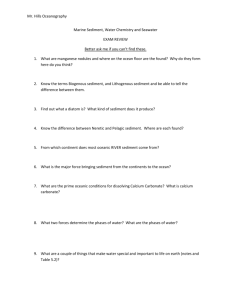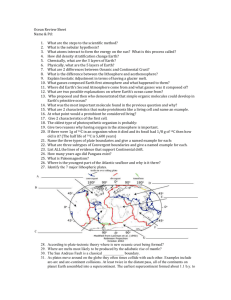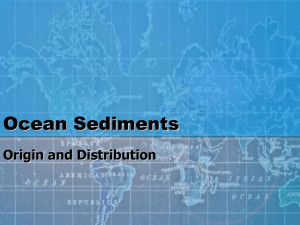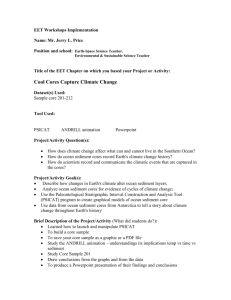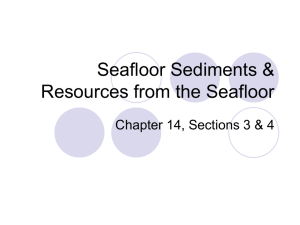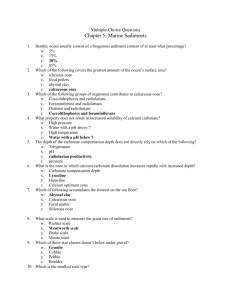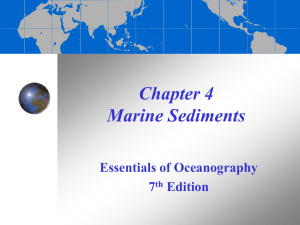MARINE SEDIMENTS - Raleigh Charter High School
advertisement
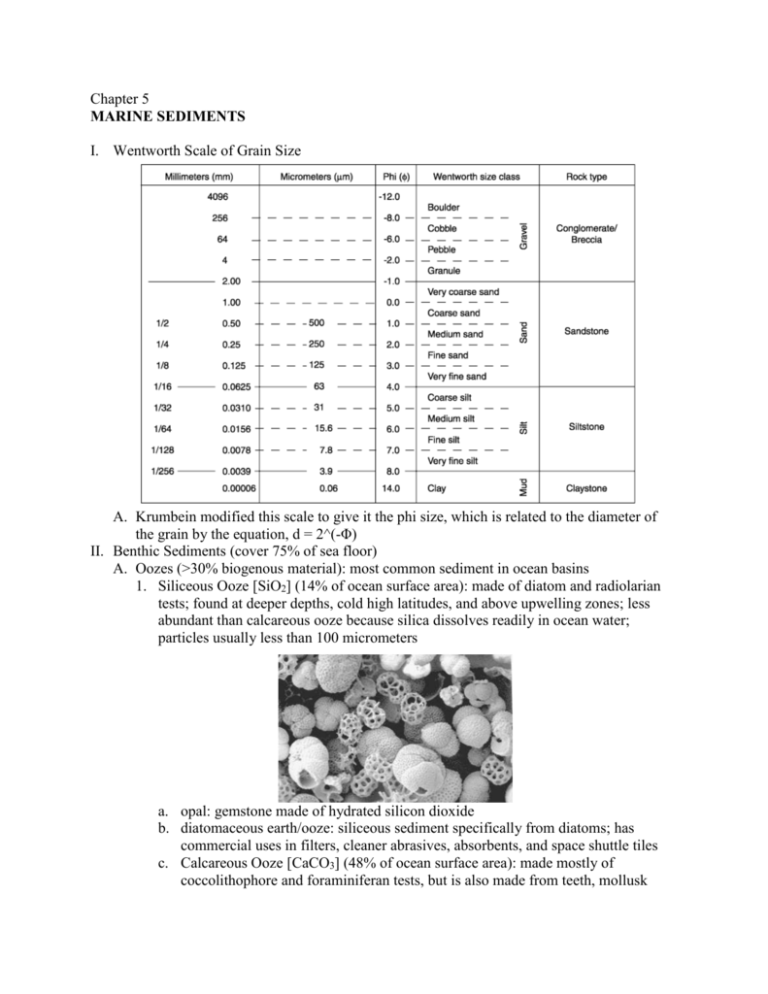
Chapter 5 MARINE SEDIMENTS I. Wentworth Scale of Grain Size A. Krumbein modified this scale to give it the phi size, which is related to the diameter of the grain by the equation, d = 2^(-Φ) II. Benthic Sediments (cover 75% of sea floor) A. Oozes (>30% biogenous material): most common sediment in ocean basins 1. Siliceous Ooze [SiO2] (14% of ocean surface area): made of diatom and radiolarian tests; found at deeper depths, cold high latitudes, and above upwelling zones; less abundant than calcareous ooze because silica dissolves readily in ocean water; particles usually less than 100 micrometers a. opal: gemstone made of hydrated silicon dioxide b. diatomaceous earth/ooze: siliceous sediment specifically from diatoms; has commercial uses in filters, cleaner abrasives, absorbents, and space shuttle tiles c. Calcareous Ooze [CaCO3] (48% of ocean surface area): made mostly of coccolithophore and foraminiferan tests, but is also made from teeth, mollusk shells, bones, and coral remains; dissolves under high pressure (at great depths) and in acidic water; only found in shallower water (< 4500 m), usually on midocean ridges; found more in the mid and low latitudes B. Abyssal Clay (38% of ocean surface area): greater than 70% clay content; accumulates very slowly (1 mm/1000 yrs) on deep ocean floors; oxidized iron is red-brown; terrigenous; clay particles are flat and very cohesive III. Sediment Classifications (based on source) Type of Sediment Source Example(s) Lithogenous Cosmogenous other rocks: volcanoes, continents, rivers, glaciers remains of living organisms (usually plankton) space volcanic ash, ferromagnesian minerals (iron, silicate, magnesium compound), igneous rocks (extrusive=finegrained, intrusive=coarse-grained) calcium carbonate [CaCO3] (foraminiferans, coccolithophores, coral reefs), silica [SiO2] (diatoms, radiolarians), stromatolites, fecal pellets nickel-iron spherules, tektites, chondrites Hydrogenous [authigenic] precipitation of ions dissolved in water Biogenous A. B. C. D. E. F. manganese nodules (manganese, iron, nickel, cobalt, copper), phosphorite nodules [P2O5] (grow down into sediment), metal sulfides, oolites, evaporites tektite (cosmogenous): sediment made of silica that is smooth due to quick cooling upon striking ocean surface after arriving from space chondrite (cosmogenous): any silicate rock from space spherule (cosmogenous): any small, globular mass from space consisting of silicates, iron, or nickel oolite (hydrogenous): round rock formed in layers from precipitation of calcium carbonate around a “seed” of some sort, which can be a shell fragment, tooth, etc. phosphorite (hydrogenous): mined for use in fertilizers fecal pellets (biogenous): detritus from macroscopic consumers; responsible for carrying 99% of biogenous material to the ocean floor because fecal pellets sink fast and tests do not G. stromatolites (biogenous): dome-shaped calcareous sedimentary structures in shallow water that have been built up in layers by ancient cyanobacteria H. salt dome (hydrogenous): large, cylindrical, underground deposit of evaporites consisting mostly of sodium chloride; mined for the salt I. cobalt crusts: hard coatings of cobalt, a blue metal, on other rocks; considered a strategic resource because cobalt is used in strong metal alloys J. gypsum, halite (hydrogenous): these evaporites are two of the most economically useful minerals; halite [NaCl] is table salt; gypsum [CaSO4] is used in drywall and plaster IV. Sediments, Minerals, Rocks, and Erosion A. neritic deposit: sediment on the continental shelf; most lithogenous sediments are neritic, not pelagic B. pelagic deposit: sediment in the ocean basin C. relict sediments: old sediments on the continental shelf D. Turbidites are carried by turbidity currents down the continental slope. They are deposited at the edge of the continental margin to form the continental rise. Graded bedding is produced. The layers of this bedding contain progressively larger particles at the bottom. Smaller particles are on top because it takes them longer to settle after a turbidity current carries them down the slope. Deep-sea/submarine fans are associated with turbidite deposits. E. clastic rock: consists of fragments of older rocks (ex: sandstone) F. glacial deposits: poorly sorted sediment from glaciers on the continental shelf; many formed during the Pleistocene Epoch 1. rafting: sediments are carried from shore by icebergs and deposited in the ocean basin when they melt G. three basic rock classifications 1. igneous 2. metamorphic 3. sedimentary H. terrigenous sediment: comes from rock on land I. weathering: the breaking up of rock into sediment; can be mechanical (ex: rain) or chemical J. erosion: the weathering and transport of sediment K. sorting: a description of the uniformity of sediment particles; a sandy beach is well sorted, but a mix of sand, silt, and clay is poorly sorted L. sediment maturity: increases as the sediment moves away from its source; results in: 1. more sorting of particles 2. decreased clay content 3. rounding of grains such as sand M. calcium carbonate [CaCO3] minerals 1. limestone, chalk 2. calcite: composition of some organisms’ shells 3. aragonite: composition of some organisms’ shells that is more soluble V. Other A. dredge: bucketlike device used to collect benthic sediments in early exploration of the oceans B. core: cylindrical sample of sediment retrieved from ocean drilling 1. rotary drilling: modern process of collecting a core 2. gravity coring: old process of obtaining a core C. Sahara desert is the source of many suspended lithogenous sediments D. gas hydrates: compact deposits under the ocean floor made of frozen water containing natural gas, such as methane; form under high pressure and low temperatures E. radiometric dating: way to determine ages of sediments using half-lives of isotopes F. activation analysis: bombardment of samples of rock, water, or fossils with neutrons in order to find the concentration of a certain element in the sample G. Hjulstrom’s diagram: shows the fate of sediment with a certain size traveling at a particular speed; the sediment can be eroded, transported, or deposited

